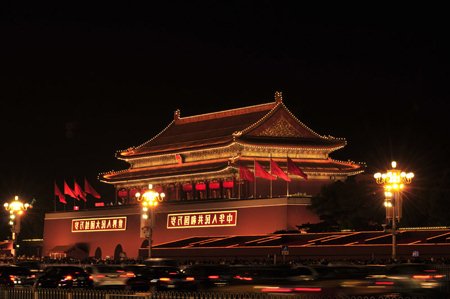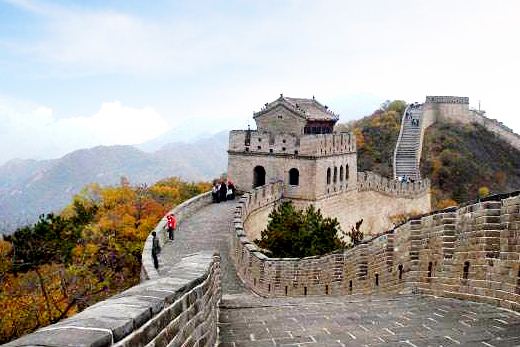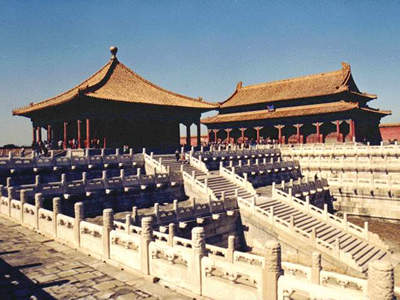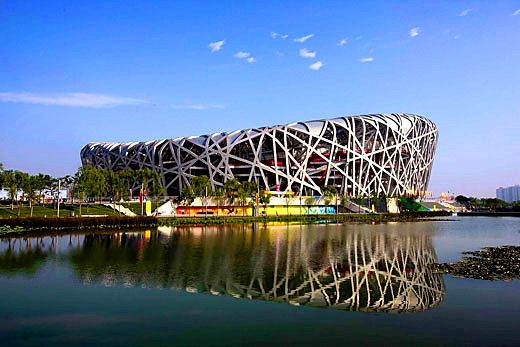 This is the world's largest public square, the size of 90 American football fields (40 hectares/99 acres), with standing room for 300,000 people. It is surrounded by the Forbidden City in the north, the Great Hall of the People in the west, and the museums of Chinese History and Chinese Revolution in the east. In the center of the square stands the Monument to the People's Heroes (Renmin Yingxiong Jinian Bei), a 37m (124-ft.) granite obelisk erected in 1958, engraved with scenes from famous uprisings and bearing a central inscription (in Mao's handwriting): THE PEOPLE'S HEROES ARE IMMORTAL. The twin-tiered dais is said to be an intentional contrast to the imperial preference for three-tiered platforms; the yin of the people's martyrs contrasted with the yang of the emperors.
This is the world's largest public square, the size of 90 American football fields (40 hectares/99 acres), with standing room for 300,000 people. It is surrounded by the Forbidden City in the north, the Great Hall of the People in the west, and the museums of Chinese History and Chinese Revolution in the east. In the center of the square stands the Monument to the People's Heroes (Renmin Yingxiong Jinian Bei), a 37m (124-ft.) granite obelisk erected in 1958, engraved with scenes from famous uprisings and bearing a central inscription (in Mao's handwriting): THE PEOPLE'S HEROES ARE IMMORTAL. The twin-tiered dais is said to be an intentional contrast to the imperial preference for three-tiered platforms; the yin of the people's martyrs contrasted with the yang of the emperors.
Tian An Men (Gate of Heavenly Peace) was the main entrance to the Forbidden City during the Ming and Qing Dynasties. Built in 1417, it was first named the Cheng Tian Men, meaning that emperors obeyed the order of Heaven in ruling the country. Destroyed by fire twice, it was rebuilt in 1651 during the Qing Dynasty and renamed Tian An Men. It is also honored as the "Gate of the Nation."
During the Ming and Qing Dynasties grand ceremonies were held at Tian An Men. Composed of the rostrum and gate tower, the building is 34.7 meters high and has five watchtowers. Supported by nine huge columns, the building has a splendid colorful roof of glazed tiles. With painted pillars and carved beams, the hall of Tian An Men Rostrum looks majestic. Sixty huge columns, representing the Earthly Branches designate years, months, days and hours and the Heavenly stems to designate marks of order, stand in perfect harmony to demonstrate the permanent stability of the nation. Tian An Men, a masterpiece of China's ancient architectural art, represents the superb skill and artistic talent of the Chinese people.
Must See
Huabiao on the Tiananmen Square: A well-known architectural ornament in China is the huabiao, often seen on the grounds of palaces, imperial gardens and mausoleums. It is also seen at some crossroads to mark the throroughfares. There is a pair of such ornamental pillars carved out of marble standing in front and behind Tian'anmen, the Gate of Heavenly Peace, at the centre of Beijing. Each pillar, entwined by a divine dragon engraved in relief, carried a plate on top called CHENGLUPAN for collecting dew,on which squats an animal called kong .
On the square's north end is the Gate of Heavenly Peace, which leads towards the Forbidden City. Above the gate hangs the famous portrait of Chairman Mao. On both sides of the gate are inscriptions in Chinese: the one on the left says, "Lone Live the People's Republic of China"; the one on the right declares, "Long Live the Unity of the people of the World." For a panoramic view of the spuare, ascend to the panoramic view of the spuare, ascend to the top of the Gate, where Mao proclaimed the establishment of the PRC.
In the center of the square is the 40m-high Monument to the ;People's Heroes, an obelisk with friezes de;picting revolutionary heroes and calligraphy by Mao Zedong and former Premier Zhou Enlai. South of the monument is the Chairman Mao's Mausoleum, where you can peer at the embalmed figure of the Great Helmsman in his glass casket. Standing guard over the square's southern end, behind the mausoleum, is 600-year-old Qianmen one of the few remaining Ming-era city gates. The building on the Spuare's east side houses the Chinese History and Revolution Museum
The imposing edifice on the west side of Tian'anmen Square is the Great Hall of the People. Built in a speedy 10 months in 1958 to 1959, it's home to China's parliament , the National People's Congress.


 About Beijing
About Beijing 


